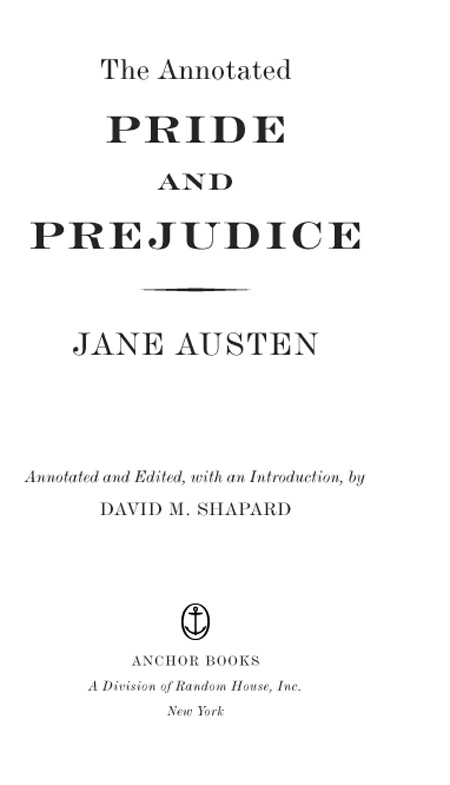The Annotated Pride and Prejudice
Annotations to the Front Cover

Jane Austen's sister, Cassandra, painted this picture of their niece, Fanny Austen Knight. Fanny's surname resulted from her father's adoption by distant relations named Knight who left their estate to him. This reasonably common procedure could explain the difference in name of Mr. Bennet and Mr. Collins in the novel, despite their common paternal ancestry.
Fanny was very close to Austen, often asking her advice about love and marriage. In her replies, Austen acknowledges the economic benefits of marriage for women but also argues firmly, in words she repeats almost verbatim in Pride and Prejudice, that one should never marry without love.
Fanny's sketching, like Cassandra's execution of this picture, suggests how many ladies drew or painted at that time. Such accomplishments were highly valued in young ladies; the Bennet girls are criticized for their inability to draw.
Fanny's dress is typical of period fashions, which favored high waists, soft flowing fabrics, and light colors.
The Annotated
PRIDE AND PREJUDICE
Annotated and Edited by
DAVID M. SHAPARD

David Shapard graduated with a Ph.D. in European History from the University of California at Berkeley; his specialty was the eighteenth century. Since then he has taught at several colleges. He lives in upstate New York.

The cottage at Chawton, Hampshire. This was where Jane Austen lived in the last part of her life, and where she wrote most of her novels.
[From Mary Augusta Austen-Leigh, Personal Aspects of Jane Austen (New York, 1920), p. 112]

Contents

Notes to the Reader
Acknowledgments
Introduction
PRIDE AND PREJUDICE
VOLUME I
(Note: The following chapter headings are not found in the novel. They are added here by the editor to assist the reader.)
I Mr. and Mrs. Bennet
II The Bennet Family
III The First Dance
IV Elizabeth and Jane
V The Miss Bennets and the Miss Lucases
VI The Party at the Lucases
VII Jane Invited to Netherfield
VIII Elizabeth's First Evening at Netherfield
IX Visit of Mrs. Bennet
X Elizabeth Debating Darcy
XI Discussion of Darcy and Pride
XII Departure from Netherfield
XIII Arrival of Mr. Collins
XIV An Evening with Mr. Collins
XV Encounter of Darcy and Wickham
XVI Elizabeth and Wickham
XVII Preparations for the Ball
XVIII The Ball at Netherfield
XIX Elizabeth and Mr. Collins
XX End of Mr. Collins's Offer
XXI News of Bingley's Departure
XXII Mr. Collins and Charlotte
XXIII The Reaction of the Bennets
VOLUME II
I Despair over Bingley
II The Gardiners' Christmas Visit
III Jane's Stay with the Gardiners
IV Elizabeth's Stop in London
V Elizabeth's Arrival at Charlotte's
VI Dinner with Lady Catherine
VII Arrival of Darcy
VIII An Evening at Lady Catherine's
IX Darcy's Visit
X Elizabeth and Colonel Fitzwilliam
XI The Proposal
XII Darcy's Letter
XIII Reaction to the Letter
XIV Farewell to Lady Catherine
XV Departure of Elizabeth
XVI Elizabeth's Return Home
XVII Elizabeth's Revelation to Jane
XVIII Lydia's Departure for Brighton
XIX Beginning of Northern Tour
VOLUME III
I Encounter at Pemberley
II Visit of Darcy and Bingley
III Second Visit to Pemberley
IV News about Lydia
V Return of the Travelers
VI The Wait for Further News
VII Announcement of the Engagement
VIII Reaction to the Engagement
IX Lydia's Return
X Mrs. Gardiner's Letter
XI Return to Netherfield
XII Dinner at the Bennets
XIII Bingley and Jane
XIV Lady Catherine's Visit
XV Mr. Bennet Teasing Elizabeth
XVI Elizabeth and Darcy
XVII Surprise of the Bennets
XVIII Discussion of Earlier Events
XIX Conclusion
Notes on the Text of the Novel
Chronology
Bibliography
Maps
Notes to the Reader

The Annotated Pride and Prejudice contains several features that the reader should be aware of:
Plot disclosures: a number of annotations allude to later developments in the story, as does the introduction. Such allusions are essential to making a variety of points, but they can spoil the surprise for anyone unfamilar with the story. First-time readers might therefore prefer to read the text of the novel first, and then to read the annotations and introduction.
Literary interpretations: the comments on the techniques and themes of the novel, more than other types of entries, represent the personal views and interpretations of the editor. Such views have been carefully considered, but nevertheless they will inevitably provoke disagreement among some readers. I can only hope that even in those cases, the opinions expressed provide useful food for thought.
Differences of meaning: many words then, like many words now, had multiple meanings. The meaning of a word that is given at any particular place is intended only to apply to the way the word is used at that point in the text; it does not represent a complete definition of the word in the language of the time. Thus some words are defined differently at different points, while many words are only defined in certain places, since in other places they are used in ways that remain familiar today.
Repetitions: this book has been designed so it can be used as a reference.
1 comment